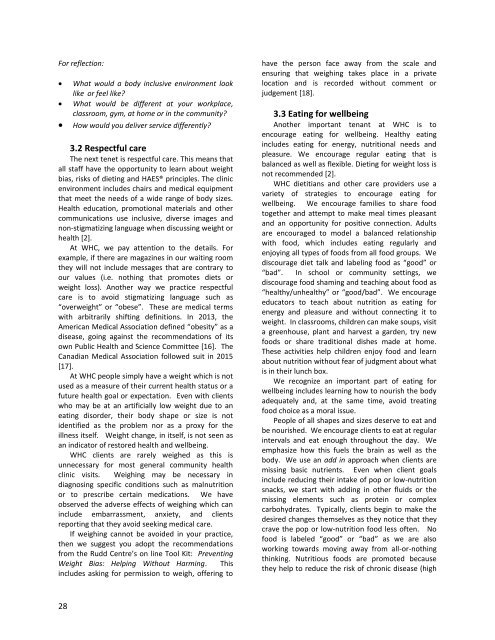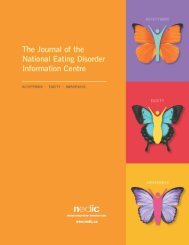NEDIC Conference Journal 2018
You also want an ePaper? Increase the reach of your titles
YUMPU automatically turns print PDFs into web optimized ePapers that Google loves.
For reflection:<br />
<br />
<br />
<br />
What would a body inclusive environment look<br />
like or feel like?<br />
What would be different at your workplace,<br />
classroom, gym, at home or in the community?<br />
How would you deliver service differently?<br />
3.2 Respectful care<br />
The next tenet is respectful care. This means that<br />
all staff have the opportunity to learn about weight<br />
bias, risks of dieting and HAES® principles. The clinic<br />
environment includes chairs and medical equipment<br />
that meet the needs of a wide range of body sizes.<br />
Health education, promotional materials and other<br />
communications use inclusive, diverse images and<br />
non-stigmatizing language when discussing weight or<br />
health [2].<br />
At WHC, we pay attention to the details. For<br />
example, if there are magazines in our waiting room<br />
they will not include messages that are contrary to<br />
our values (i.e. nothing that promotes diets or<br />
weight loss). Another way we practice respectful<br />
care is to avoid stigmatizing language such as<br />
“overweight” or “obese”. These are medical terms<br />
with arbitrarily shifting definitions. In 2013, the<br />
American Medical Association defined “obesity” as a<br />
disease, going against the recommendations of its<br />
own Public Health and Science Committee [16]. The<br />
Canadian Medical Association followed suit in 2015<br />
[17].<br />
At WHC people simply have a weight which is not<br />
used as a measure of their current health status or a<br />
future health goal or expectation. Even with clients<br />
who may be at an artificially low weight due to an<br />
eating disorder, their body shape or size is not<br />
identified as the problem nor as a proxy for the<br />
illness itself. Weight change, in itself, is not seen as<br />
an indicator of restored health and wellbeing.<br />
WHC clients are rarely weighed as this is<br />
unnecessary for most general community health<br />
clinic visits. Weighing may be necessary in<br />
diagnosing specific conditions such as malnutrition<br />
or to prescribe certain medications. We have<br />
observed the adverse effects of weighing which can<br />
include embarrassment, anxiety, and clients<br />
reporting that they avoid seeking medical care.<br />
If weighing cannot be avoided in your practice,<br />
then we suggest you adopt the recommendations<br />
from the Rudd Centre’s on line Tool Kit: Preventing<br />
Weight Bias: Helping Without Harming. This<br />
includes asking for permission to weigh, offering to<br />
have the person face away from the scale and<br />
ensuring that weighing takes place in a private<br />
location and is recorded without comment or<br />
judgement [18].<br />
3.3 Eating for wellbeing<br />
Another important tenant at WHC is to<br />
encourage eating for wellbeing. Healthy eating<br />
includes eating for energy, nutritional needs and<br />
pleasure. We encourage regular eating that is<br />
balanced as well as flexible. Dieting for weight loss is<br />
not recommended [2].<br />
WHC dietitians and other care providers use a<br />
variety of strategies to encourage eating for<br />
wellbeing. We encourage families to share food<br />
together and attempt to make meal times pleasant<br />
and an opportunity for positive connection. Adults<br />
are encouraged to model a balanced relationship<br />
with food, which includes eating regularly and<br />
enjoying all types of foods from all food groups. We<br />
discourage diet talk and labeling food as “good” or<br />
“bad”. In school or community settings, we<br />
discourage food shaming and teaching about food as<br />
“healthy/unhealthy” or “good/bad”. We encourage<br />
educators to teach about nutrition as eating for<br />
energy and pleasure and without connecting it to<br />
weight. In classrooms, children can make soups, visit<br />
a greenhouse, plant and harvest a garden, try new<br />
foods or share traditional dishes made at home.<br />
These activities help children enjoy food and learn<br />
about nutrition without fear of judgment about what<br />
is in their lunch box.<br />
We recognize an important part of eating for<br />
wellbeing includes learning how to nourish the body<br />
adequately and, at the same time, avoid treating<br />
food choice as a moral issue.<br />
People of all shapes and sizes deserve to eat and<br />
be nourished. We encourage clients to eat at regular<br />
intervals and eat enough throughout the day. We<br />
emphasize how this fuels the brain as well as the<br />
body. We use an add in approach when clients are<br />
missing basic nutrients. Even when client goals<br />
include reducing their intake of pop or low-nutrition<br />
snacks, we start with adding in other fluids or the<br />
missing elements such as protein or complex<br />
carbohydrates. Typically, clients begin to make the<br />
desired changes themselves as they notice that they<br />
crave the pop or low-nutrition food less often. No<br />
food is labeled “good” or “bad” as we are also<br />
working towards moving away from all-or-nothing<br />
thinking. Nutritious foods are promoted because<br />
they help to reduce the risk of chronic disease (high<br />
28




